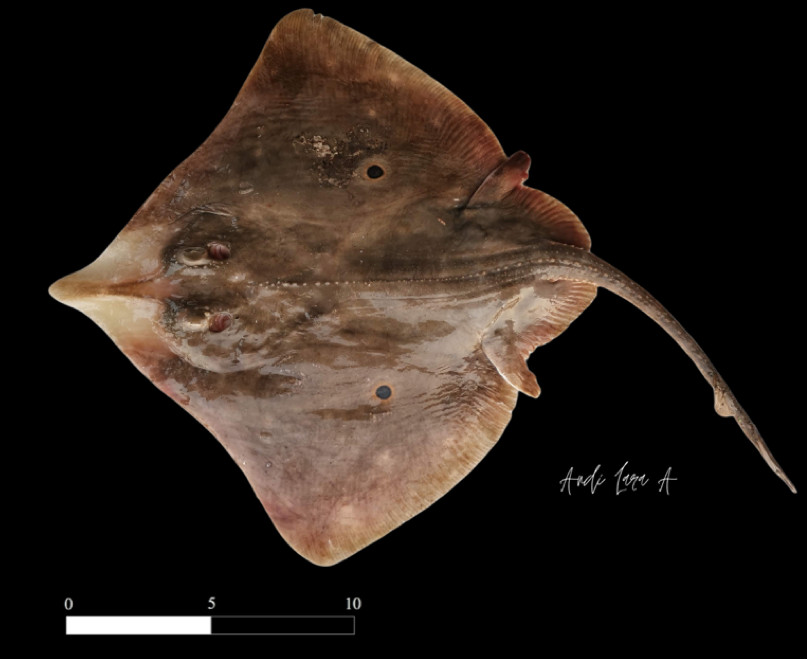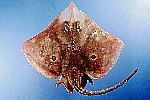Rostroraja texana
(Chandler, 1921)
Roundel skate
Classification: Elasmobranchii Rajiformes Rajidae
Reference of the original description
A new species of ray from the Texas coast, and report of the occurrence of a top minnow new to the fauna of eastern Texas. Proceedings of the United States National Museum, 59(2393), 657–658
A new species of ray from the Texas coast, and report of the occurrence of a top minnow new to the fauna of eastern Texas. Proceedings of the United States National Museum, 59(2393), 657–658
Image of the original description
No image in first description.
No image in first description.
Synonyms / new combinations and misspellings
Raia texana, Raja texana, Raja (Raja) texana
Raia texana, Raja texana, Raja (Raja) texana
Description :
Citation: Rostroraja texana (Chandler, 1921): In: Database of modern sharks, rays and chimaeras, www.shark-references.com, World Wide Web electronic publication, Version 12/2025
Please send your images of "Rostroraja texana" to info@shark-references.com

Rostroraja texana (Chandler, 1921), Costa Central de Veracruz, México. © Andi Alexander Lara Alcantara

Rostroraja texana (Chandler, 1921), Costa Central de Veracruz, México. © Andi Alexander Lara Alcantara
Common names
 Raya,
Raya,  Raya tejana,
Raya tejana,  Raya tigre,
Raya tigre,  Raie tourteau,
Raie tourteau,  Roundel skate
Roundel skate
 Raya,
Raya,  Raya tejana,
Raya tejana,  Raya tigre,
Raya tigre,  Raie tourteau,
Raie tourteau,  Roundel skate
Roundel skate
Short Description
Disk diamond-shaped; round dark spot surrounded by pale ring on base of each pectoral fin. [17659]. No small pale or dark spots on upper surface of disk, but sometimes dark blotches. No scapular spines, 1 middorsal row of spines. Distance from ocellus to eye usually less than or about equal to distance between ocelli. Snout with a clear area on each side [17658]. Upper surface rich chocolate or coffee brown, translucent on either side fo rostral cartilage. Lower surface plain white [199].
Disk diamond-shaped; round dark spot surrounded by pale ring on base of each pectoral fin. [17659]. No small pale or dark spots on upper surface of disk, but sometimes dark blotches. No scapular spines, 1 middorsal row of spines. Distance from ocellus to eye usually less than or about equal to distance between ocelli. Snout with a clear area on each side [17658]. Upper surface rich chocolate or coffee brown, translucent on either side fo rostral cartilage. Lower surface plain white [199].
Human uses
fisheries: minor commercial; bait: occasionally; price category: medium; price reliability: questionable: based on ex-vessel price for species in this genus
fisheries: minor commercial; bait: occasionally; price category: medium; price reliability: questionable: based on ex-vessel price for species in this genus
Biology
Oviparous, paired eggs are laid. Embryos feed solely on yolk [733]. Distinct pairing with embrace. oung may tend to follow large objects, such as their mother [17086]. Occurs from near shore to 183 m depth at temperatures ranging from 14 to 28° C but it is most common inshore of 91 m at 16 to 25° C. Young occur in shallow bays. Feeds mainly on decapod crustaceans and to a lesser extent on other benthic invertebrates and fishes.
Oviparous, paired eggs are laid. Embryos feed solely on yolk [733]. Distinct pairing with embrace. oung may tend to follow large objects, such as their mother [17086]. Occurs from near shore to 183 m depth at temperatures ranging from 14 to 28° C but it is most common inshore of 91 m at 16 to 25° C. Young occur in shallow bays. Feeds mainly on decapod crustaceans and to a lesser extent on other benthic invertebrates and fishes.
Habitat
demersal; marine; depth range ? - 183 m
demersal; marine; depth range ? - 183 m
Remarks
shark-references Species-ID=14798;
shark-references Species-ID=14798;
Parasites (arranged by Jürgen Pollerspöck)
Cestoda
Cestoda
- Acanthobothrium floridense Goldstein, 1964 [13116] [28741]
- Acanthobothrium ulmeri Vardo-Zalik & Campbell, 2011 [13116] [28741]
- Acanthobothrium westi Vardo-Zalik & Campbell, 2011 [13116] [28741]

















